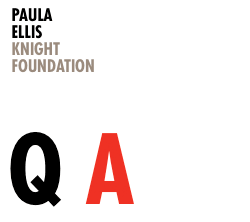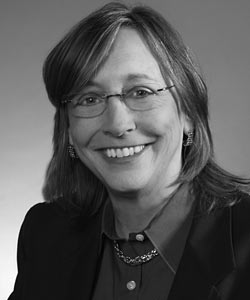Sponsors
Paula Ellis is Vice President for Strategic Initiatives at the John S. and James L. Knight Foundation, where she is in charge of "transformational funds" -- money that supports transformative projects that lead to informed and engaged communities. A journalist for three decades, Ellis is interested in using new media, which values co-creation and participation, to develop strong, resilient communities.

- The beginning of Knight Foundation was heavily influenced by Clara Knight, the mother of Jack and Jim Knight. What's her story, and how does her vision influence yours?
- Like many philanthropists, Jack and Jim Knight learned the importance of giving back to community from family. Well before there was a foundation, their mother Clara helped influence the family to establish an education fund -- loans and scholarships -- that provided financial support to scores of young people in attain a college education. And, many of those young recipients became great contributors to their own communities. Prior to 1950, the Knight brothers -- who would later own the country's largest newspaper chain Knight Ridder -- began what would become Knight Foundation with a little more than $9,000. Their interest was in promoting quality journalism and strengthening the communities where they lived and worked. Fifteen years later, their mother Clara, upon her death, gave the foundation its first major infusion of assets. Her gift opened the way for Knight Foundation to make a significant mark. Today, the foundation's mission is promoting informed and engaged communities -- just like the Knight family did for decades through their newspapers.
- Tell me about the Knight Technology for Engagement Initiative. What are a few of the projects you're tracking? Who are some women who are leaders in this field?
- We're all seeing how social networks like Facebook have become the place to make a statement, whether it's supporting Haiti, ending hunger, or any other of a range of causes. But those clicks aren't necessarily turning into a movement to better communities -- at least they haven't yet. With an eye on promoting informed and engaged communities, we started looking at ways to take that online energy a step further, and transform it into on-the-ground action.
- This summer, we launched the Knight Technology Engagement Initiative, which will initially invest $2.23 mil lion in five projects that use the latest digital tools to help people connect for the greater good. I'll give you two examples. We're funding Code for America, founded by Jennifer Pahlka, which wants to transform city governments across the country by enlisting the nation's most promising developers to apply Web 2.0 principles to civic problems. They are using the Teach for America model, and recruiting the country's best and brightest to create web applications to help make city governments more transparent, inclusive and efficient. Another is CEOs for Cities, led by Carol Coletta, which will test whether residents can help create solutions to local problems, filling a gap left by shrinking budgets. This project will connect developers and city officials to build a crowd-sourcing platform that invites citizens to work with government to identify problems and find answers. We can't wait to see what they come up with.
- The Knight News Challenge has seen some really significant winners who are women, or who work with women and communication. Can you tell me more about this contest, and maybe one or two stories from winners? I'd love to hear more about Video Volunteers, from India, and Freedom Zone, in Zimbabwe.
- The Knight News Challenge is a media innovation contest. We look for new ways to digitally inform communities -- think mobile apps and other new technologies -- in hopes of advancing the future of news. There is so much uncertainty in the media industry now, and nobody has all the answers. Knight Foundation's strategy is highly experimental. We believe that the more experiments we seed, the more approaches we explore, the more likely we are to find innovations that will serve communities and strengthen journalism in the digital age.
- News Challenge winners include Jessica Mayberry, whose Video Volunteers project is training people in rural India as community video producers, so they can create news reports about local issues. The stories are broadcast on widescreen projectors in poor com- munities, to reach the largest amount of people. The people gathered then discuss each video and talk about what they want to do about what they've seen. It is a wonderful example of how information and civic engagement work together. Jessica founded the program after spending a year training rural Indian women in filmmaking. In Zimbabwe, Bev Clark is launching Freedom Fone, to provide a voice database where users can access news and public-interest information via land, mobile or Internet phones. It's similar to a telephone tree, where users can call in and then dial specific numbers to find the information they need. Independent radio station content will be broadcast, along with frequently updated audio reports created specifically for Freedom Fone.
- You're a journalist yourself. Do you have a personal story of community engagement that drives you in your work?
- Everyday people taking action to improve their individual or collective lives inspire me. It's easiest to see this in times of a clear and present danger. Hurricanes are a great example. I've been involved with coverage of several storms and their aftermath, including some of the most destructive -- Andrew, Hugo, Floyd and Katrina. In the face of each of these tragedies, you see the best and worst of humankind. There is an immediate, desperate need for useful information -- about the safety of loved ones, damage reports and how to get help. But there's also an important psychological need to see yourself as part of a community -- your community -- and to know if civilization is intact. There is no greater sense of the commons than at this time when each individual realizes his or her well-being is tied to the shared success of others.
- That's why hundreds of people would line up outside the hobbled newspaper building waiting for the daily report. And that's why we promised ourselves in each instance we wouldn't miss
a day of publication -- no matter what. That's why ordinary people do extraordinary things, rising above their own sense of the possible. Individuals are more willing to trust, because they must. They are more able to offer and receive help. They are more empathetic.

